Skate and Meditate
The line up of teams included notables Team Team, Team Omelette, Boils n’Warts, D.H.S.S. (Dundee Hardcore Skate Squad), Team Manic (England/Scotland), Factory Sensibles, and Angel Lights (A & B). The street and ramp team competitions were to be on Saturday, with the individual over and under 16 street and ramp events on Sunday — but this was a ‘fun comp’, so things changed and happened (which you missed cause other things were going on) without warning. Under the circumstances it was the best way of letting it run: people just want to skate, so let them get on with it.
The scene on the ramp was giving strong indications of what could be expected: a gnarly snake session was taking place, the platforms were diving-board city, and hefty bags of tricks were being thrown around. But a small change started to take place as the members of Team Team began to ascend the many transitions. High on their domination of the previous evening’s session, they began to assault the ramp in a style seldom seen: dropping into the ramp and carving around it with determination, speed and aggression.
The event began and things got going pretty quickly. (more…)
-
Dundee Factory Skatepark Competition 1989 (Part 3)
-
Vision Streetwear Advert November 1989
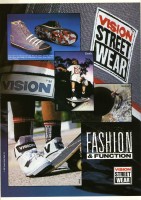 Vision Streetwear were the shoes which defined one brief era in British skate fashion. They never really crossed-over into the fashion mainstream here and so stayed an identifying brand for skaters and BMXers. In the USA things were different, I believe: they started selling in mainstream shops and provided an early prototype for the whole crossover into urban fashion which was to fuel (and fund) the skate market at the turn of the century.
Vision Streetwear were the shoes which defined one brief era in British skate fashion. They never really crossed-over into the fashion mainstream here and so stayed an identifying brand for skaters and BMXers. In the USA things were different, I believe: they started selling in mainstream shops and provided an early prototype for the whole crossover into urban fashion which was to fuel (and fund) the skate market at the turn of the century.
-
Dundee Factory Skatepark Competition 1989 (Part 2)
 The inset photographs show Davie Philip (caption: Tailslide from Mr Philip — you can assume this covered yards) and Snoz (In a traditional contest nose stalls to fakie would have rated higher).
The inset photographs show Davie Philip (caption: Tailslide from Mr Philip — you can assume this covered yards) and Snoz (In a traditional contest nose stalls to fakie would have rated higher).
Main picture is of Chimp, I think, and someone I can’t identify. The more I look at this picture, the more I like it. At the time I think we might have been wary of giving it so much space, but it needs to be seen full size to work well. The intensity of the movement around Chimp’s board and face would have been lost otherwise.
-
Anarchy Skateboard Jam in Dundee
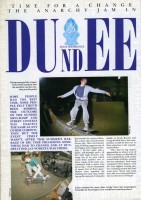 We clearly couldn’t make up our minds what to call this report on the 1989 skateboard competition at the Factory in Dundee. There’s a reference to jam in there (Dundee is famous for “jute, jam and journalism”) as well as yet another line from the film Performance (“time for a change”) and in fact the typesetting file contains several other variations.
We clearly couldn’t make up our minds what to call this report on the 1989 skateboard competition at the Factory in Dundee. There’s a reference to jam in there (Dundee is famous for “jute, jam and journalism”) as well as yet another line from the film Performance (“time for a change”) and in fact the typesetting file contains several other variations.
Dundee has played an important part in the history of Scottish skateboarding and has a long tradition of BMX and skater-built facilities. The full history of The Factory Skatepark is a long and interesting one. This article is about a competition at the park when it was based on Perth Road in what has now become the DCA (Dundee Contemporary Arts) centre. [No it wasn’t! See Rick Curran’s update below. I’m confusing this with a later competition — the one Simon Evans wrote about as “Dundee Cake” perhaps. This incarnation of the Factory was the one in Arthurstone Terrace.]
As well as the purpose-built indoor skatepark, Dundee also boasts a great outdoor skatepark these days. I was there at Easter this year and gazed on it in wonder and quiet delight. Back in the days of R.a.D we would never have dreampt there would be facilities like that popping up all over the place: Livingston was still very much a one-off. Enough of that. On with the story:TIME FOR A CHANGE
THE ANARCHY JAM IN DUNDEE
Skate and MeditateSome people had the best time. Some people felt they’d been robbed. The outcome of the dundee mini-ramp and street contest was exactly the same as any other competition. But the event itself wasn’t. After this summer’s barrage of big time pro-shows something had to change and at dundee it did. Jay podesta was there.
Just outside the centre of Dundee a dusty old council owned factory sits. This conveniently large building supports one of the biggest mini ramps in Britain — 28 feet wide, with a spine, roll-through and a 10 feet wide high sections. The ramp sits in an area which could hold another two to three ramps of the same size, combined with a street area just as big — there’s thousands of square feet of floor space. Skaters have squatted the building for some time, building up the amount of obstacles inside, so locals Barclay and Craig decided that a fun competition would be best way to draw attention to the expanding facilities.
They had no big money sponsorship to attract a lot of different skaters, so the idea of team competition, with a slant toward local rivalries, seemed the best substitute. Each team consisted of five skaters, with the four highest scoring skaters counting toward the final team score. Street and ramp were the two events and Saturday was the day it all began.Captions:
Chimp emerged the winner from all the mayhem. But the mayhem, not the winning was the point.
Lines counted for more than ‘tricks’ here, but Lonnergan’s frontside air from high to low would have rated anywhere.
-
Skater Owned Shops Adverts November 1989
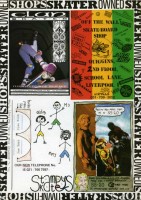 This is an interesting example of the original Skater-Owned-Shops group getting together to buy a page of colour advertising, I think. Or maybe it was a Billy Brown idea to create a special page for them. SS20 and Clan were in for the long haul, representing Glasgow and Oxford. Stampys in Birmingham and Off the Wall from Liverpool fell by the wayside eventually. I like the Sean Goff clay model. Shades of “Skateboard Madness” stop-frame animation there. Was it a Jim Watmough creation, I wonder?
This is an interesting example of the original Skater-Owned-Shops group getting together to buy a page of colour advertising, I think. Or maybe it was a Billy Brown idea to create a special page for them. SS20 and Clan were in for the long haul, representing Glasgow and Oxford. Stampys in Birmingham and Off the Wall from Liverpool fell by the wayside eventually. I like the Sean Goff clay model. Shades of “Skateboard Madness” stop-frame animation there. Was it a Jim Watmough creation, I wonder?
-
Skateboard Classified Adverts November 1989
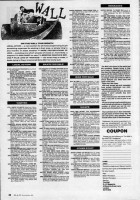 I don’t seem to be able to find the file containing the text from this lot. Now there’s a relief!
I don’t seem to be able to find the file containing the text from this lot. Now there’s a relief!
Of course I reserve the right to retro-fit it here one day for the sake of completists.
I’ve just glanced at the form for submitting entries and noticed that we insisted that you had to tell us your age and which parts of the magazine you liked most and least. Even back then I was very keen to analyse the audience response at every opportunity. We didn’t compile formal statistics, but it was a very useful bit of feedback to go alongside our annual reader survey. The contents of the classified adverts themselves also provided insight into what was going on at street level, much in the same way as blogs and on-line forums do now. But we had to do all the typing ourselves, or, rather, I did: nobody else would touch it.
-
Skate City and Skateboard Gang Adverts November 1989
 I’m intrigued by the “Skateboard Gang” (shades of Thrashing in that title) video. I know nothing about it. It wasn’t from one of the mainstream companies, and it wasn’t something happening underground in the UK. Our lines of information came from those two sources, most of the time. Anything outside of that seemed alien to us.
I’m intrigued by the “Skateboard Gang” (shades of Thrashing in that title) video. I know nothing about it. It wasn’t from one of the mainstream companies, and it wasn’t something happening underground in the UK. Our lines of information came from those two sources, most of the time. Anything outside of that seemed alien to us.
I suspect we would have largely ignored this on the assumption that it was some “non-skate” company trying to jump on the skateboarding bandwaggon. We were very supsicious of anyone who hadn’t been around the main skateboard scene for years.
I wonder if things are much better now? The channels for communication are more varied now but I suspect it’s still just as difficult for new voices to be heard and new companies to find a market.
Skate City Bromley were in there as ever — an example from the opposite side: a shop which had been around for years, steadily supplying their local scene (mini-ramp on the derelict site next to the shop etc).
-
Whose Line is It Anyway? (Part 7)
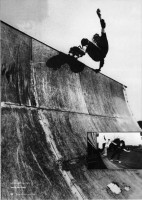 The main picture of Jeff Hedges is by Claus Grabke. I wish we had run more like that now. Inset shows Mark Abbott and Shane O’Brien.
The main picture of Jeff Hedges is by Claus Grabke. I wish we had run more like that now. Inset shows Mark Abbott and Shane O’Brien.
This was the last page of a remarkably long feature. Too long perhaps, but it does provide an interesting sense of the skateboard culture in Britain back in 1989. In April 2006 there was thread in the Sidewalk magazine forum discussing how little things had changed.
-
Whose Line is it Anyway (Part 6)
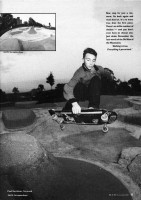 Paul Davidson at Bloblands (Norwood Park), just up the hill from the sad quarter pipe on the cover of Rollin’ Through the Decades and just down the road from where I sit writing this.
Paul Davidson at Bloblands (Norwood Park), just up the hill from the sad quarter pipe on the cover of Rollin’ Through the Decades and just down the road from where I sit writing this. Now stop for just a moment. Go back again and read that lot. It’s no more true than the first piece. There’s an inifite number of choices — and you don’t even have to choose one. Just skate. Remember the last words of the Old Man of the Mountains:
“Nothing is true,
Everything is permitted.”And that’s another theme which underlies the whole history of R.a.D. The quotation is from Nic Roeg and Donald Cammell’s film “Performance” — there were plenty more scattered through R.a.D over the years. I’d sneak them in whenever I could.
-
Whose Line is it Anyway (Part 5)
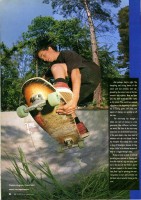 The skater was credited as Patrick Hughes [actually Pat Phillips, see correction below], shown here at the private mini-bowl on the St George’s (?) estate in Weybridge. This was (and still is) a posh private estate with its own security force and home to sundry celebrities, including some of the Beatles at one point. This bowl had been built for a skater who had since grown up and left home. His family were happy for other people to carry on using it.
The skater was credited as Patrick Hughes [actually Pat Phillips, see correction below], shown here at the private mini-bowl on the St George’s (?) estate in Weybridge. This was (and still is) a posh private estate with its own security force and home to sundry celebrities, including some of the Beatles at one point. This bowl had been built for a skater who had since grown up and left home. His family were happy for other people to carry on using it.And perhaps they’re right. The freestyling and racing heroes of the sixties and mid seventies were supplanted by the vertical stars of the late seventies and eighties. Now we have pros who have established their name on the streets. That would have seemed ridiculous at the beginning of eighties, but as skating grows, new areas, new aspects of skating, are opening up all the time.
The mini-ramp has brought a whole new style of skating to a new generation. New, different: not better, not worse. The lines of the mini- ramp wizard are not the direction based lines of the park skaters, they have more in common with the trick based lines of the freestyler. But nobody feels a need to slag off freestylers because all they do are ‘tricks’ or a slalomer because all they do is wiggle through cones.
If you can only see lines in terms of travelling over concrete, or flowing patterns the width of a big vert ramp, then you’re the one with the blinkers, you’re the one trapped in the mental tramlines. And if you’re spending time worrying about it, that’s your problem, not the bloke who is actually skating on the mini.
